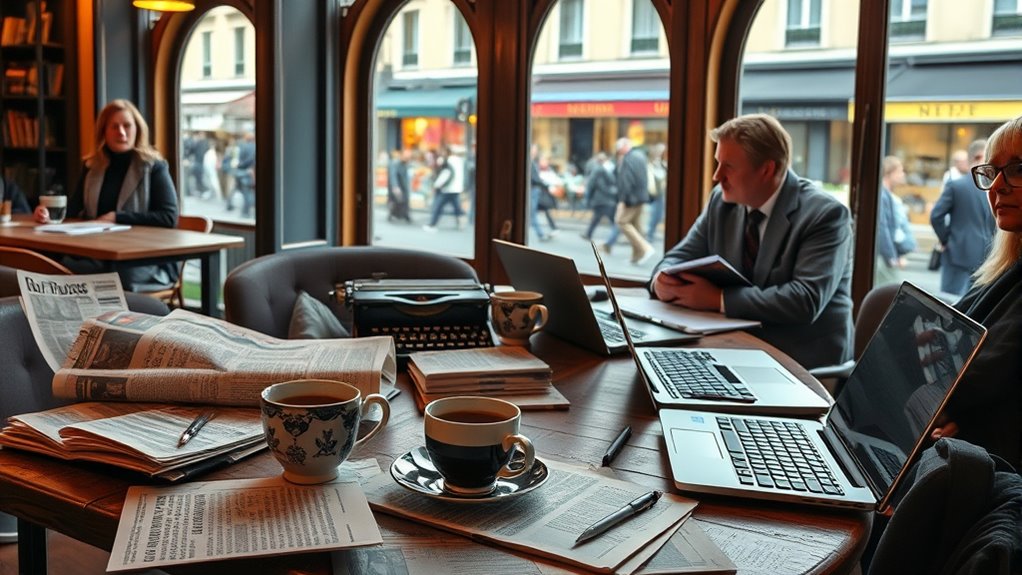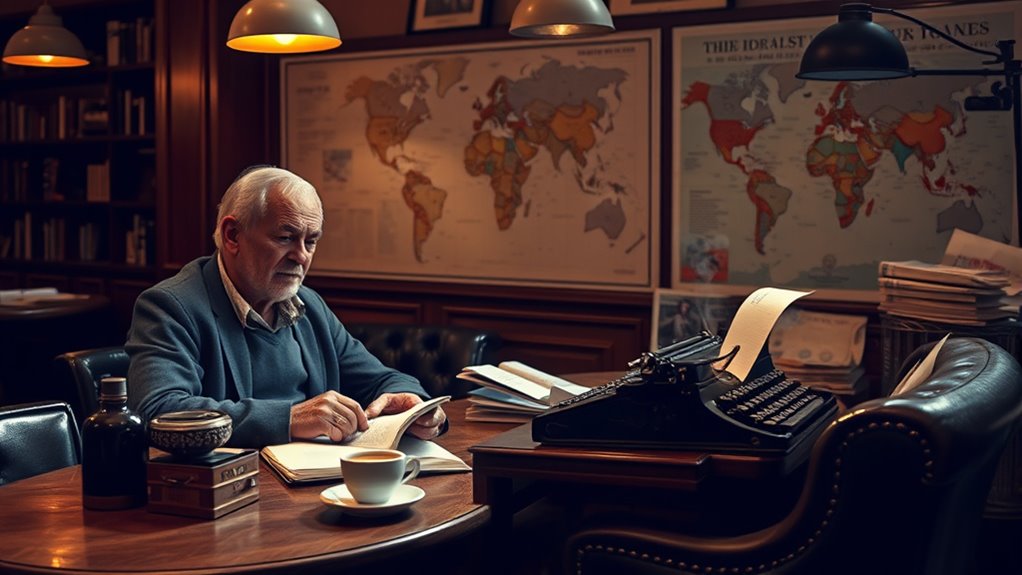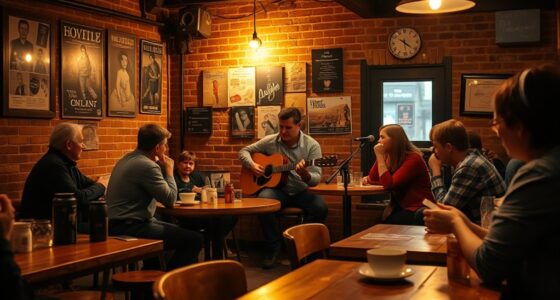Cafés serve as vibrant spaces where foreign correspondents blend storytelling with local engagement, shaping journalism rooted in culture and community. In these informal settings, you can witness firsthand cultural nuances and gather authentic insights, while media literacy helps you evaluate sources and filter noise. By immersing yourself in these lively hubs, you’ll understand how coffee-fueled conversations influence reporting. Continue exploring to discover how these social spaces redefine international journalism and deepen cultural understanding.
Key Takeaways
- Cafés serve as informal hubs for foreign correspondents to gather local insights and develop stories organically.
- Coffeehouse environments facilitate candid conversations, enriching international reporting with authentic cultural perspectives.
- Media literacy helps journalists verify information obtained in cafés, ensuring credible and responsible foreign reporting.
- Cafés foster community engagement, allowing foreign correspondents to build trust and deepen understanding of local dynamics.
- The casual setting of cafés enables spontaneous interactions, leading to timely and nuanced international news coverage.

In recent years, journalism from cafés has become a vibrant way for reporters and storytellers to connect with their communities. This approach isn’t just about enjoying a warm beverage; it’s about creating a space where ideas flow freely and stories develop organically. As a foreign correspondent, you find yourself immersed in these lively environments, where conversations spark and perspectives collide. These cafés serve as informal hubs for information exchange, allowing you to observe and participate in the cultural fabric of the community you’re covering. You quickly realize that the role of media literacy is vital here, as it helps you sift through the noise and understand what’s genuinely significant. Being able to analyze sources and distinguish facts from opinions ensures your stories are accurate and trustworthy. Additionally, understanding the impact of color accuracy on visual storytelling can enhance the way images and videos complement your written reports.
Cultural influence plays a massive part in shaping how stories are told and received in these settings. When you sit in a café, you’re not just observing the news; you’re experiencing the culture firsthand. The local customs, language nuances, and social dynamics influence your reporting style and the stories you choose to highlight. This environment allows you to build trust within the community, as your presence and engagement demonstrate genuine interest and respect for local traditions. Furthermore, your interactions in these cafés help you grasp the underlying cultural currents that influence public opinion and societal values. This deep understanding enriches your journalism, making your stories more authentic and resonant with your audience.
The informal nature of café journalism also cultivates a sense of immediacy and intimacy that traditional newsrooms often lack. You’re more likely to have candid conversations with locals, hear personal anecdotes, and gather insights that wouldn’t surface in a formal interview setting. These spontaneous exchanges can lead to powerful narratives that capture the community’s spirit. However, it’s essential to navigate this space responsibly, using your media literacy skills to verify information and avoid spreading misinformation. Your role is to portray a balanced and truthful picture, respecting the cultural influences at play while maintaining journalistic integrity.
Ultimately, journalism from cafés allows you to blend storytelling with cultural exchange, fostering a more nuanced understanding of the world around you. It’s a dynamic, engaging approach that emphasizes the importance of media literacy and cultural influence in shaping compelling, responsible journalism. Through these interactions, you become not just a reporter but a participant in the community’s ongoing story, capturing its essence in every word you write.
Frequently Asked Questions
How Did Cafés Become Popular Meeting Spots for Journalists Historically?
Cafés became popular meeting spots for journalists because of their role in fostering café culture and supporting reporter traditions. You’ll find that these spots offer a relaxed environment where journalists can exchange ideas, gather information, and build networks. Historically, cafés provided accessible, informal spaces free from office constraints, making them ideal for spontaneous conversations and collaborative work, which helped shape journalistic practices and fostered a sense of community among reporters.
What Role Do Cafés Play in Shaping International News Narratives?
They say “a picture is worth a thousand words,” but in coffee culture, cafés shape international news narratives more subtly. You influence stories by exchanging ideas and building trust over coffee, which fosters open dialogue. Cafés act as hubs where journalists and locals share perspectives, ultimately guiding the narrative influence. Your presence in these spaces helps frame stories, making cafés essential in shaping global perceptions and understanding.
Are There Famous Cafés Associated With Particular Foreign Correspondents?
Yes, there are famous cafés linked to notable foreign correspondents. For example, Café de Flore in Paris became a hub for journalists like Ernest Hemingway and Simone de Beauvoir, shaping coffee culture and becoming historic landmarks. You can imagine how these cafés serve as inspiring spaces where reporters gather, exchange ideas, and influence international narratives, blending the rich history of journalism with the vibrant ambiance of iconic coffee spots.
How Has Digital Communication Affected Journalists Working From Cafés?
Digital communication has transformed how you work from cafés by enabling seamless social media integration and instant news updates. You can share stories, gather information, and verify facts in real-time, all while enjoying your coffee. This immediacy allows you to respond quickly to breaking events and engage with your audience directly. As a result, your reporting becomes more dynamic, connected, and timely, enhancing your effectiveness as a journalist on the go.
What Are the Challenges of Maintaining Journalistic Integrity in Casual Café Settings?
You face challenges maintaining journalistic integrity in casual café settings, like protecting confidential sources and managing bias. The relaxed environment can lead to distractions or unintended disclosures, risking source confidentiality. Additionally, the informal setting might tempt you to let personal opinions influence your reporting. To stay honest, you must stay vigilant, safeguard sources, and consciously check biases, ensuring your work remains trustworthy despite the casual surroundings.
Conclusion
Next time you sip your coffee, remember that journalism from cafés isn’t just a tradition—it’s a essential link to the world. As foreign correspondents type away, they blend the old-world charm of cafés with modern reporting, echoing the days of the telegram. So, when you read about distant lands, you’re also witnessing a timeless dance of words, coffee, and connection—proof that some stories, much like a good espresso, only get better with time.









